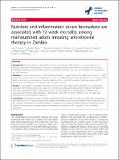| dc.contributor.author | Blevins, Meridith | |
| dc.contributor.author | Nyirenda, Christopher | |
| dc.contributor.author | Zulu, Isaac | |
| dc.contributor.author | Mwango, Albert | |
| dc.contributor.author | Koethe, John R. | |
| dc.contributor.author | Kabagambe, Edmond K. | |
| dc.contributor.author | Shepherd, Bryan E. | |
| dc.contributor.author | Wester, C. William | |
| dc.contributor.author | Chiasera, Janelle M. | |
| dc.contributor.author | Mulenga, Lloyd B. | |
| dc.contributor.author | Heimburger, Douglas C. | |
| dc.date.accessioned | 2012-06-05T00:20:11Z | |
| dc.date.issued | 2011 | |
| dc.identifier.citation | Koethe, John R., Meridith Blevins, Christopher Nyirenda, Edmond K. Kabagambe, Bryan E. Shepherd, C. William Wester, Isaac Zulu, et al. 2011. Nutrition and inflammation serum biomarkers are associated with 12-week mortality among malnourished adults initiating antiretroviral therapy in Zambia. Journal of the International AIDS Society 14(1): 19. | en_US |
| dc.identifier.issn | 1758-2652 | en_US |
| dc.identifier.uri | http://nrs.harvard.edu/urn-3:HUL.InstRepos:8830767 | |
| dc.description.abstract | Background: A low body mass index (BMI) at antiretroviral therapy (ART) initiation is a strong predictor of mortality among HIV-infected adults in resource-constrained settings. The relationship between nutrition and inflammation-related serum biomarkers and early treatment outcomes (e.g., less than 90 days) in this population is not well described. Methods: An observational cohort of 142 HIV-infected adults in Lusaka, Zambia, with BMI under \(16 kg/m^2\) or \(CD4^+\) lymphocyte counts of less than \(50 cells/mm^3\), or both, was followed prospectively during the first 12 weeks of ART. Baseline and serial post-treatment phosphate, albumin, ferritin and highly sensitive C-reactive protein (hsCRP) serum levels were measured. The primary outcome was mortality. Results: Lower baseline phosphate and albumin serum levels, and higher ferritin and hsCRP, were significantly associated with mortality prior to 12 weeks (p < 0.05 for all comparisons), independent of known risk factors for early ART-associated mortality in sub-Saharan Africa. The time-dependent interval change in albumin was associated with mortality after adjusting for the baseline value (AHR 0.62 [0.43, 0.89] per 5 g/L increase), but changes in the other biomarkers were not. Conclusions: The predictive value of serum biomarkers for early mortality in a cohort of adults with malnutrition and advanced HIV in a resource-constrained setting was primarily driven by pre-treatment values, rather than post-ART changes. Interventions to promote earlier HIV diagnosis and treatment, address nutritional deficiencies, and identify the etiologies of increased systemic inflammation may improve ART outcomes in this vulnerable population. | en_US |
| dc.language.iso | en_US | en_US |
| dc.publisher | BioMed Central | en_US |
| dc.relation.isversionof | doi:10.1186/1758-2652-14-19 | en_US |
| dc.relation.hasversion | http://www.ncbi.nlm.nih.gov/pmc/articles/PMC3094357 | en_US |
| dash.license | LAA | |
| dc.title | Nutrition and Inflammation Serum Biomarkers Are Associated with 12-Week Mortality among Malnourished Adults Initiating Antiretroviral Therapy in Zambia | en_US |
| dc.type | Journal Article | en_US |
| dc.description.version | Version of Record | en_US |
| dc.relation.journal | Journal of the International AIDS Society | en_US |
| dash.depositing.author | Wester, C. William | |
| dc.date.available | 2012-06-05T00:20:11Z | |
| dash.affiliation.other | SPH^Immunology and Infectious Diseases | en_US |
| dc.identifier.doi | 10.1186/1758-2652-14-19 | * |
| dash.authorsordered | false | |
| dash.contributor.affiliated | Wester, C | |


